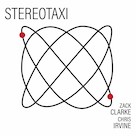

Zack Clarke & Chris Irvine: Stereotaxi
Panoramic Recordings
On Stereotaxi, pianist Zack Clarke and cellist Chris Irvine flex their considerable muscles as players and improvisers. It's not the first time the two have worked together, Clarke having appeared on Irvine's 2013 debut album Dialectic and the cellist doing the same on the pianist's Clean Feed release Mesophase. Stereotaxi has elements of both releases in its DNA: it has the chamber music and improv dimensions of Mesophase (not, however, its electronic music component) and the improv aspect of Dialectic, which includes unscripted responses to material by Bach. In building on the duo's backgrounds in jazz, improv, experimental music, and classical, the fourteen pieces on Stereotaxi invite the label chamber jazz, as reductive as that label (or any, for that matter) is.
An alumnus of The New England Conservatory and NYU, Clarke is a New York-based Greek-American artist of omnivorous appetites, someone as capable of issuing a jazz trio recording (Vertical Shores) as an experimental electronics-based one (Plunge). Born in Cleveland, Irvine is a NYC-based teacher and new music advocate who's on faculty at Brooklyn Conservatory of Music and Silver Music in Manhattan. Clear evidence of the rapport the two've developed and the sensibility they share is heard in the ease and authority of these performances, which are in most cases concise statements lasting two to three minutes at a time. That makes for focused and taut expressions that are free of the meandering waywardness that sometimes weakens the impact of a long-form improv. The duets by Clarke and Irvine are clear and direct in the paths they follow and directions they pursue.
The album begins with a burst of energy in “Gliding Through,” each player scampering at rapid speed and entwining assertively with the other. Attentive listening is immediately evident in the complementary paths they carve out and the dynamics they shape in tandem. Much less frenetic is the quasi-classical “Fragments of Sunrise,” which stakes out a contemplative space with sparse piano chords and minimal bowed phrases. “Sit Still” reinstates the animation of the opener, the title subverted by darting flurries of piano and pizzicato textures.
While classical composers aren't overtly referenced, there are moments during the classically tinged settings where echoes of Bartok, Messiaen, and Debussy might be heard. The jazz dimension emerges in places surreptitiously, in “Confrontation,” for example, where the pianist's playing hints at swing. There are also times when a fellow jazz explorer is suggested by the playing; in “Dancing on Fumes” and "Stride Me to the Moon,” Irvine's plucking calls to mind Hank Roberts, who one might presume to be a kindred spirit.
Irvine exploits the sound potential of the cello in drawing upon a large number of techniques, from glissandi and harmonics to multiphonics and pizzicato. While Clarke doesn't venture inside the piano, he too draws on the extensive expressive history associated with his instrument. Hear, for example, the oceanic swells he generates alongside Irvine during the evocative tone painting “Waking in Water.” Contrasts of mood and tone are also plentiful, with some pieces exuberant roller-coaster rides and others inward-looking meditations. Such differences are sometimes cued by titles, the plaintive reflection “Sorrow Song” and the furious battle-grounds that are “Confrontation” and “Volcanic Conniption” cases in point.
The focus on brevity is taken to an even further extreme when “6 Miniatures” and “4 Short Pieces” collect micro-compositions of varying character under collective titles. In exceeding eight minutes, “Dreams of Weight” naturally stands apart from the others, and it is fascinating to witness how the two interact over a longer stretch of time and navigate the way forward in tandem. In being improvs, the material grants unbounded freedom to Clarke and Irvine and liberates them from having to focus on replicating notated charts and fashioning their performances in accordance with them. Even though most of the pieces are compact, the two venture far afield when the customary constraints are absent, and both appear to fervently embrace the opportunity to exchange conventional notions of harmony and tonality for freer modes of expression.May 2025